




I had a pretty special moment with my son Blake recently. I wanted to share it with you all. Personal growth often comes in times of stress, fear and change.
Almost a year and a half ago, and I can still see it vividly, I was captaining a 32-foot center console shing boat. Blake and a friend were up front on the bow seats. His buddy’s dad and another of my friends were at the helm.
We were all excited about an afternoon on the water. As I approached an area known as “The Race” we unexpectedly hit a large wave moving too fast. The boys were both launched into the air. Blake’s friend landed comfortably back in his seat. Blake did not.
Blake came crashing back to the boat. His face hit squarely on the berglass bow and steel bow rail. I can still hear the fear and pain in his crying. He was bleeding from both nostrils and his chin immediately began to swell. Fortunately, his teeth were intact, and he passed a “ eld test” for concussion (my other passengers were a PT and an ATC).
Since that day, we have had the opportunity to get on a boat four or ve times. Each time, I have seen and sensed his fear. He has openly spoken of “it happening again.” Gradually, the memory seemed to be fading. The ocean: being in it, on it, or near it, brings me great joy. I cannot explain the guilt I have over potentially ruining that for my teenage son. This spring I purchased a twenty-year-old 18-foot shing boat. My hope was that giving him some experience on a smaller boat and maybe driving it would help him move forward.
After we nally got access to it a few weeks ago, the weather wasn’t great, and the few times we might have gone out, Blake found a reason not to. I was disappointed; however, I knew forcing him could make matters worse.
The other night, I got home from work and announced “I am going shing tonight. I’d like you to come with me, but it’s your choice.” Blake reluctantly agreed to come along. I talked him through the start-up procedures of turning on the battery, lowering the engine, powering the electronics, etc. His rst observation, “Dad, this is a very small boat.”
We decided to troll for striped bass close to the beach. We could see some “birds working” over schools of bait. Thirty minutes into the trip a rod bent, and it was game on. I coached Blake as he landed the biggest sh of his life. He did a nice job with the rod, and I netted a 38-inch Striper. A few minutes later, he boated a second sh of nearly the same size!
We high ved and took a few pictures. After showing him how to safely revive and release each sh, I asked him, “Now what?” Blake responded, “Can I drive the boat around for a while?”
Hesitantly at rst, and then with greater and greater con dence, he ran the boat through wide sweeping turns and faster straightaways. He had a big smile on his face the entire time.
It was dark by the time we tied the boat back to the mooring. On the way in he said, “I understand why people love boats...I feel a connection to the ocean.”
I hope this summer you're able to spend quality time with those you love, take some risks, make desired change and be proud of personal growth.
Thanks for all you do,

Alan



Clinician’s Corner by Julianna Lusk, Essex Physical Therapist Hypermobility Syndromes: A Rising Trend in Young Female Athletes
Employee Spotlight: Andrew Perazella, New Haven PT
Prompt: Tracking Patient Engagement with Home Exercise Programs (HEP)
DEI: Putting De-escalation into Practice By Marilex Santiago
LifeBeat: Preventative Care
Techy Tips: Keeping Your Sensitive Information Secure By Dave
Lawrence
RSVP for the Yard Goats Game on September 8th by August 10th.


Julianna Lusk, PT, DPT Physical Therapist at PTSMC Essex
Hypermobility syndromes have become increasingly prominent in the realm of physical therapy, capturing attention for their complex challenges and specialized treatment needs. At our clinic, we've noted a rising number of referrals for "whole body PT," often involving young female athletes who exhibit symptoms of generalized hypermobility syndrome. These individuals, whether diagnosed or undiagnosed, frequently present after experiencing multiple sports-related injuries exacerbated by their inherent joint instability and impaired proprioception. Such conditions predispose them to frequent occurrences of sprains, dislocations/subluxations, chondromalacia, and even fractures.
It's no coincidence that hypermobility tends to peak among adolescent females, typically around the age of 15, which explains why this demographic consistently appears on our caseloads. Beyond joint-related issues, patients with hypermobility syndromes may also manifest various neuromusculoskeletal signs and symptoms such as scoliosis, bromyalgia, chronic fatigue syndrome, nerve compression disorders, chronic pain, gastrointestinal disturbances, chronic headaches, and immune system dysregulation.
Diagnosing hypermobility syndrome involves speci c criteria:
• Major criteria include a Beighton Score of ≥ 4/9 and persistent arthralgia (joint pain) lasting more than three months in more than four joints.
• Minor criteria encompass a Beighton score of 1–3, arthralgia in 1–3 joints, history of joint dislocation, presence of soft tissue lesions greater than three, Marfan-like physique, skin striae or scarring indicative of hyperextensibility, eye signs showing lid laxity, and a history of varicose veins, hernia, or visceral prolapse.



To establish a diagnosis, an individual must meet:
• Two major criteria
• One major criterion plus two minor criteria
• Four minor criteria
• Two minor criteria along with a con rmed case of hypermobility syndrome in a rst-degree relative
During our assessments, we employ the Beighton scale as a quick screening tool to gauge the extent of hypermobility in our patients. This scale is attached for reference. This tool helps guide our treatment approach, which emphasizes active management rather than relying solely on medication. While NSAIDs can be used for pain management as needed, our therapy focuses on proactive strategies.
Key components of our treatment programming for hypermobile patients include:
• Closed chain exercises to enhance joint stability
• Proprioception exercises to improve body awareness
• Techniques to maintain neutral joint positions
• Dynamic control re-training
• Motion control training to manage hypermobility
Equally critical to successful management is patient education. Many individuals with hypermobility syndromes have been conditioned to view their exibility as an asset, particularly in sports where extreme ranges of motion are valued. As a retired hypermobile cheerleader myself, I can relate to the allure of showcasing "cool tricks" that often involved pushing my joints beyond their limits, unwittingly exacerbating my own instability.
It's crucial for patients to understand that while certain sports may demand high levels of exibility, achieving long-term health and longevity requires balanced strength and control throughout all ranges of motion. As musculoskeletal specialists, it's our responsibility to educate patients on achieving this balance to mitigate pain, instability, and other associated symptoms.
In conclusion, hypermobility syndromes represent a multifaceted challenge that demands a holistic treatment approach. By combining targeted physical therapy interventions with patient education, we aim to empower individuals with hypermobility syndromes to manage their condition e ectively, enhance their athletic performance, and improve their overall quality of life.
SMT 1: High Velocity Low Amplitude Thrust Manipulation of the Cervical, Thoracic, Lumbar, & Sacroiliac Joints
September 21-22, 2024
Instructed by American Academy of Manipulation at PTSMC Guilford
Upper Extremity
September 28, 2024
*DOCS Program Requirement at PTSMC Branford
Instructed by Andrew Kalach, PT, DPT, OCS, CMTPT
Lower Extremity
November 2, 2024
*DOCS Program Requirement at PTSMC Wallingford
Instructed by Melissa Boutagy, PT, DPT, OCS
Visit the ERC Clinical Excellence folder for all future course information.
Email ConEd@ptsmc.com to register for PTSMC courses or with any Clinical Excellence questions.
Calling all clinicians! We are looking to expand our clinical enrichment o erings to students on an a liation with PTSMC. Reminder to please take 3 minutes to complete a survey to share about your caseload and what unique patient populations you are working with.
Click here to respond: Caseload Survey
All who respond will be entered into a ra e for a $25 Amazon gift card. We’ve expanded the deadline. The survey will be open through 8/5.
Thank you for your time improving the quality of our students’ experiences!


By Melissa Boutagy, Guilford PT & Clinical Compliance O cer
Within Prompt, you can e ectively monitor and support your patients' adherence to their home exercise programs (HEP), leading to better outcomes and enhanced patient satisfaction. Navigate to the Engagement tab under HEP to get started.

The Engagement Tab provides insights into:
• Login Activity: Track the dates and times a patient logged into their HEP.
• Session Details: Review the exercises and activities completed during each session.

If a patient leaves a comment:
1. Click on the "Note" icon to view their feedback.
All meetings are 12:00-1:00 pm on TEAMS.
Upcoming CD dates: 08/06, 09/10
Upcoming JC dates: 08/20, 09/24
Go to

2. The primary physical therapist (case PT) will receive a noti cation via the bell alert system, ensuring timely follow-up.


Charleson Augustin Plainville Traveler PT

Evelyn Villarreal Laclede Lock Street Traveler PT

Sophia Cappolla Wallingford PT Aide
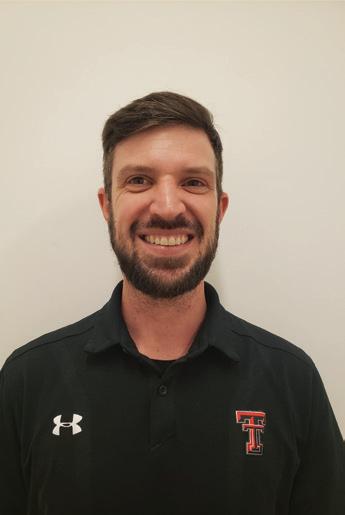
Jim Laclede Lock Street Traveler PT

James Covill IT Technician

Julia Pearson Windsor PT Aide

Luis Crespo Orange PT Aide

Ben Villa West Hartford PT Aide
Let’s Go Paperless in ADP- a chance to win a $15 gift card!
The Earth Day article in the April PULSE outlined how each of us can be more eco-friendly. PTSMC is trying to minimize paper usage by opting for digital documents. For example, all PTSMC new hires are defaulted to paperless pay statements. Now, we need your help to increase participation in paperless tax statements!

If you are not currently opted in for paperless tax statements, please consider it. Tax statements are always available to you online. Follow the steps below to change to paperless.
All employees who opt in to paperless tax statements by August 31st will be entered into a ra e to receive a $15 gift card of their choice. We will draw two winners.
To make the change in ADP:
• Click on the Myself Tab
• Under Pay click on “Pay and Tax Statements”
• If you are not currently enrolled in paperless tax statements, you will get a pop-up message asking if you’d like to go paperless.
• Under the Tax Statements section, switch the toggle to “receive paperless statements”
• Once complete, you will receive an email con rming the change has been made. Naugatuck



By Mallory Mason, Director of Culture & Engagement
In 2018, Andrew Perazella graduated from Quinnipiac’s DPT program and joined PTSMC New Haven (Prince Street). Coming out of undergraduate and PT school at QU, Andrew noticed PTSMC was in the vicinity of where he wanted to work.
Andrew grew up in Cheshire, CT and admits he was not very physically active growing up. This led to bad posture and back pain. Through that experience, he learned the importance of exercise and routine, which led him down the road to understanding the importance of the muscular-skeletal system. Professionally, this sent him down the PT track. Personally, he now keeps active in the gym and outdoors. He has gained the perspective to stay active and take care of himself now before he can’t.
Andrew loves to spend quality time out in the fresh air and considers himself spoiled to have his favorite mountain, Sleeping Giant, in his backyard. He says he is biased because he’s spent so much time hiking it since his QU days, but he never bores of it. Right before the pandemic, Andrew moved to Wallingford, so he always has access to great trails.
The pandemic also launched one of Andrew’s life passions- travel. Once restrictions were lifted in the world and people were able to travel again, he began to feel that life is short, and with that, he wanted to see the world, expand his horizons, and explore new places and cultures.

He now plans out each year to always include a trip to a new place. This journey started with a trip to Yellowstone, then the next year over to Iceland, the year after that Germany, and the latest up to Toronto and Niagara. Andrew has no plans to stop

Andrew Perazella New Haven Physical Therapist
exploring. His bucket list includes places such as Greece, Japan, and South America. He wants to experience completely di erent ways of life. Before heading out to those amazing places, he does want to return to his roots and visit Italy with his girlfriend. Andrew has a knack for history and learning through both experiences and reading, so in touristy areas you can always catch him reading every sign or plaque.

Andrew also loves to travel for food! Apartment living has taught him how important cooking is. He now would call cooking his latest hobby. He loves the creative element of cooking and creating something new. Cooking, he explained, is also very forgiving, and therefore, even more enjoyable. Andrew’s creative side also stems from his love for music. He plays the guitar, which of course has an amp, so that he can rock out to his eclectic tastes in music. His repertoire includes lots of heavy metal and rock, which doesn’t go well with apartment living, so he’s got a few friends that he goes and jams out with.
In alignment with Andrew’s love for experiencing new things and places, he is the go-to in the New Haven clinic for organizing sta outings. He’s got a system down that ensures they do something almost every month. Nothing fancy, he simply posts a signup sheet to nd the dates the most people can make it, and they nd a new place to go for happy hour on a Friday in the general New Haven/Branford area. The invite is always open for anyone else who wants to tag along!
His favorite thing to cook is vegetable soup (even if it’s hot out)!

August birthdays are located in the ERC. Click here to see the list of birthdays.

Kaylee Siguenza Patient Care
Stephanie Capito PT Aide
Devon Blizzard PT Aide
Aiden Stankiewicz PT Aide
Erin Du y PT Aide
Carlos Arteta PT Aide
Kyle Kortick PT Aide
Kate Riotte PT Aide
Arber Karamanaj PT Aide
Leah Cummings Physical Therapist
Chloe Pearce Authorization
Representative
Jaclyn Fernandez Physical Therapist
Hayley Wilson Patient Services
Coordinator
Veronica Rondinelli PT Aide
Ashley Molina Patient Services
Coordinator
Bryan Martin PT Aide
Ti any Oltjenbruns PT Aide
Michelle Laforte Athletic Trainer

Michelle Linicus PT Aide
Destinee Boyd Veri cation Representative
Lauren Zehnder Patient Services Administrator
Casey DeLucia Patient Services
Jacey Bissell Patient Services



Haven
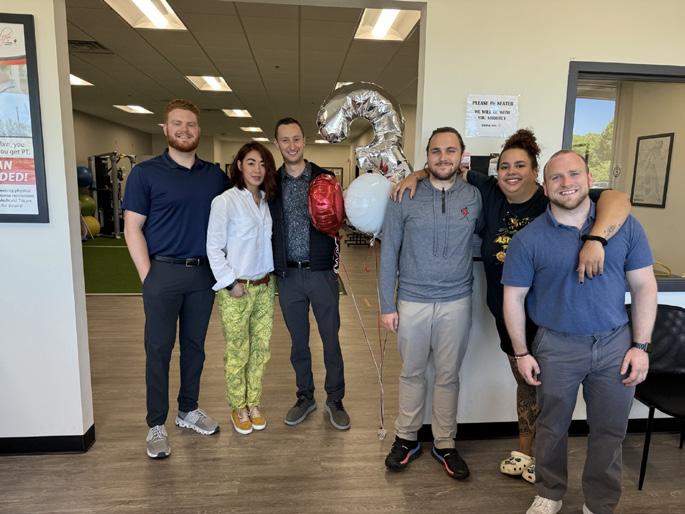


Lock Street is celebrating summer with Spirit Days! Top Left: Pride Day. Top Right: Patriotic Day/4th of July. Bottom left: College Shirt Day. Right: Theresa Nolan wore an "Ask me about our Hamden Clinic!" t-shirt in excitement for the Hamden announcement.


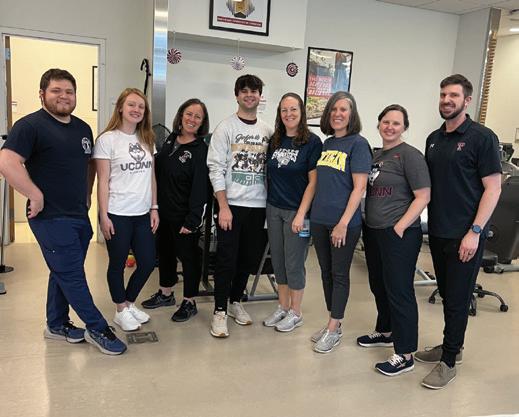
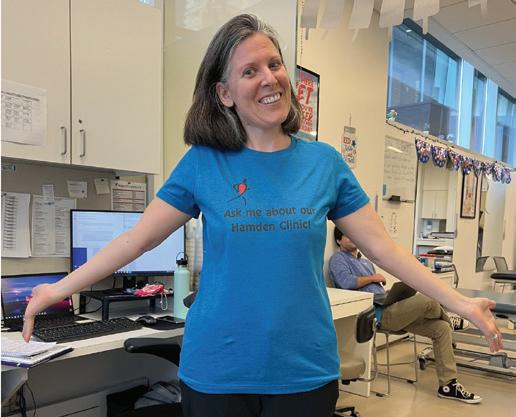
Shelton celebrated their 3-year anniversary with bagels and OJ for patients and


Did you miss the July monthly video?

Vice President of Operations Sandy
and President
discussed the Prompt transition and recognized employees who were essential to the ssuccessful EMR & Billing platform change.


Brian Greer, Glastonbury Partner & Director was published in the Journal of Manual & Manipulative Therapy. Click here to access his article, “Management of Concussion Symptoms Utilizing Mechanical Diagnosis and Therapy: a case series."

Congratulations to Michaela Houk, who was promoted to Patient Care Coordinator in New Haven.



Dan

Nick Almonte, Shelton Partner & Director, welcomed Noah Benjamin on June 29th.
“First of all, my foot got better. I think the routine of exercises, the massages and the friendly environment there contributed the healing of my foot. Very nice place for therapy. Thanks to everyone there.” - Waterbury
“My PT Brendan (Law) is always working to help my shoulder pain and really listens if something is starting to hurt so we can back o a little.”Southbury
“I have been going to physical therapy here for 18 weeks and was worried initially that surgery was the only answer to my injury. With the sta helping me to do my exercises correctly at the gym and take-home directions with images and text, I slowly began to feel less pain and sleep better. They always asked about my comfort level and adjusted exercises if necessary. It's been a challenging recovery, but I feel my constant progression of range of motion and strength is attributed to the sta of this PTSMC. Surgery is no longer a consideration. I would highly recommend them.” - Southington
“The therapist genuinely listens to your needs by personally adjusting new ways to improve whatever your condition may be. The total sta is very professional and cheerful making you feel very comfortable. You leave the therapy sessions more con dent on how to handle your wellbeing. I am completely satis ed. I would give Physical Therapy & Sports Medicine Centers an A plus plus!” - New London
“I like many things about the facility. The people are friendly and pleasant. It is a neat and well kept. The tables are sprayed down after each persons use. The equipment is updated and not old and worn. They are accommodating with my appointments. I would de nitely recommend the place to family and friends.” - Fair eld

By John Demitrus, Director of Marketing
One of the best ways we can organically connect with potential patients is at events, such as races or town celebrations. In the past, when runners were stretched at events, they would sign their name on a printed sheet, scribble their email, and then not agree to receive marketing emails. It was great for keeping track of who needed to be stretched, but it was not great for getting those contacts into our system and re-engaging them.
We’re listening to you and a recurring theme is that clinics need to generate more leads from their events. At the same time, we need to do a better job of having people who are going to receive any service, in this case, getting stretched, need to sign waiver to limit our liability. The Marketing team is thrilled to announce we are updating our process to make it more e cient and e ective using Second Door, which we are already using for our online appointment request process and connecting with current and past patients.

To improve this process, we created two event forms – 1) a waiver form for running events; and 2) a form for non-running events. At running events, anyone who signs up to be stretched will need to complete a waiver form with their name and contact information, which is consent to being stretched by a physical therapist and to receive marketing communications.
As soon as they hit submit, they will be entered into an email campaign. They will receive an email 24-48 hours after the race checking in on how they’re feeling. Our focus will be on providing educational content and will be topical and relevant to the running event.
The non-running events form will be used for ra es at events. These individuals will be entered into a similar campaign that focuses on general health education.
For races, we understand that it is important to have a list for keeping runners who need stretching in order. Don’t worry, we will provide a tracking form for this purpose still.
The capturing of information digitally allows us to re-engage with potential patients you meet at events by staying in touch so that when they need PT, they think of us!
For events moving forward, the Marketing team will provide signs with a QR code, that can be easily scanned, and the form completed. Sta will also have the link so if patients do not have their phone, you plug in and submit their information.
The Marketing team will be emailing out links to the two forms and adding these yers to the event suitcases. We are excited for this update and look forward to more e cient and e ective ways to connect with potential patients in our communities.

Making health a priority is a common start of a new year goal or theme. It’s just over halfway through to year and a great time to re ect on if you need to do a check in – with yourself and your health! Here are 3 reasons to take that check in further and see your primary care.
Save money
Not all health conditions or medical needs can be prevented, but research shows that people with a primary care provider relationship generally spend less money on health care and less time in the hospital. Better health, lower costs, and less time in the hospital: a win all around.
Be proactive about your care
Establishing a relationship with a doctor who knows you, your family history and your lifestyle can help you stay on top of your health. A primary care provider gets to know what’s normal for you, helping identify when you need additional care before it may be obvious to you.
Establish a health care “home base”
A primary care provider is your place for all things health care. They can help you identify any specialists you should see, help you locate additional care resources, order tests as necessary, and answer questions.
A family doctor, internist, general practitioner, OB/GYN (women) or pediatrician (children) can serve as your primary care provider depending on your needs and preference.


By Marilex Santiago, DEI Leader

In last month's article, we discussed de-escalation techniques for navigating potentially uncomfortable situations. Today, let's explore a hypothetical, real-world example of how an employee, Sarah, utilized these techniques to address an insensitive comment from a patient.
Scenario:
Sarah is at the front desk when new patient Beatrice walks in. Beatrice notices that Alex (he/him), a transgender patient, is waiting for his physical therapy session to begin. Beatrice, unaware of Alex's identity, glances at him and asks Sarah, "Is she here for therapy too?"
• Recognition and Awareness: This misgendering could make Alex feel uncomfortable and disrespected.
• Acknowledge and Redirect: Sarah politely acknowledges Beatrice and redirects the conversation, "Yes, he is here for PT. Can I have your name for check-in?" This subtly corrects the pronoun usage without drawing unnecessary attention.
• Private Conversation Opportunity and Support: If Alex seems visibly uncomfortable, Sarah can o er him a private space to discuss his experience. Phrases like, "Alex, if you'd like to chat about anything in private, just let me know." This demonstrates Sarah's support and creates an opportunity for Alex to express his feelings.
• Continued Education: If Beatrice directly interacts with Alex and misuses pronouns again, Sarah can politely intervene. Sarah can say, "Beatrice, Alex prefers he/him pronouns. Let’s get you back to the gym..." This addresses the situation directly but maintains a positive tone.
• Early Intervention: Address insensitive comments promptly to minimize disruption and show commitment to inclusivity.
• Respectful Communication: Use a calm and respectful tone, focusing on education rather than blame.
• Focus on Patient Care: Ultimately, the goal is to ensure all patients feel comfortable receiving quality physical therapy. Bringing the attention to a patient’s purpose of their own visit can help.
By following these steps, Sarah can address the scenario respectfully and ensure Alex feels comfortable and supported during PT.

AUGUST VIRTUAL DEI FORUM
Wednesday, August 21st from 12-12:30pm
Topic: DEI Scenarios RSVP by email to Marilex.Santiago@ptsmc.com
NOW
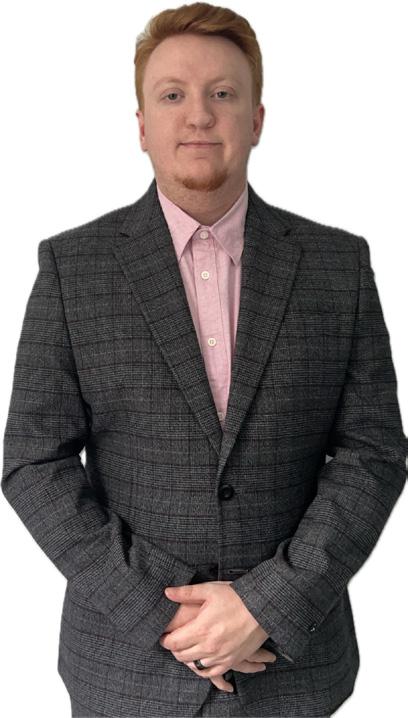
Jack Pearce epitomizes a PTSMC success story. Starting at PTSMC while in high school, Jack has worn many hats in PTSMC clinics and in administrative roles, including PT Aide, PSC, Authorization Coordinator, Senior Remote Services Coordinator, and now, Data Analyst.
When asked, “Why make this change?” Jack replied, “Being part of the growth of the VPSC department has been the highlight of my career, and it's an experience I will always cherish. However, I felt the need to make this change to focus on my schooling and personal growth. While working with the VPSC team, I discovered a passion for creating and analyzing reports, which pushed me to seek new tools and methods to improve. This newfound interest in data analysis aligned perfectly with my goal of growing both personally and professionally.” Jack will complete his bachelor’s degree in business at Eastern Connecticut State University in Spring 2025.
Jack also commented that his experience as the VPSC team lead taught him a lot about leadership and e ective communication, skills that will be helpful in his new role as a Data Analyst. He believes that e ective communication is the key to success when it comes to creating the right reports and thriving in this role.
Jack also gained a deeper understanding of the operational work ows and the intricacies of PTSMC front desk operations. This knowledge will be invaluable as a Data Analyst, where understanding the practical application of data is crucial for generating meaningful insights.
Jack also expressed his enthusiasm and gratitude: “I am excited to embark on my new journey as a Data Analyst, utilizing my experiences to create insightful reports that will bene t PTSMC. I also look forward to returning to my education to pursue my degree. I can't wait to see the incredible progress of the VPSC department under the leadership of the rockstar, Lori Lawson! I am grateful to everyone who has supported and helped my growth here at PTSMC.”
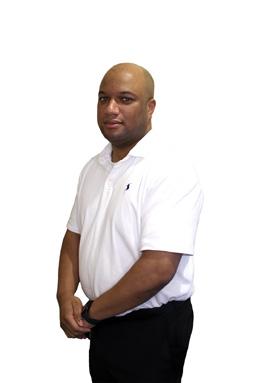
By Dave Lawrence, Director of Information Technology
In today’s world, our information is ever more at risk of ending up in the wrong hands. The best way to protect against this is to do the following:
NEVER give out personal information over the phone unless you have 100% veri ed who it is and if you trust this person.
NEVER respond to emails or text messages that ask for personal information, such as credit card information, bank information, or anything to do with money.
ALWAYS hang up immediately if someone is trying to pressure you into giving up your information. They’ll use common scamming practices to scare you and pretend to be the IRS or some other government agency. Legitimate government agencies never communicate by phone, they will most often send you a letter in the mail. Stay strong and don’t get intimidated- simply end the call!
ALWAYS validate any communication by verifying all information with the entity and if needed, request to speak to a supervisor to validate
ALWAYS travel with at least two or more credit cards to avoid bank skimming. Bank skimming is a practice by which an entity will take your payment via a credit card terminal at places like gas stations, convenience stores, etc. They will then store that information onto their system and rack up erroneous charges on your card. If you used your debit card, then that money is more than likely not going to be returned to you. There is greater legal protection by using your credit card and you get to protect your hard-earned money.
AS ALWAYS, stay vigilant and report anything suspicious!

This is part of the Prompt automation to notify patients of an open slot on their clinician’s schedule.
The work ow:
If a patient cancels, an automatic popup will appear stating either there are opportunities or no opportunities for other patients to ll that time slot.


The sta member chooses up to three patients to “o er” the slot via text. The box turns purple to let clinicians know the slot has been “o ered”.
Click on the purple box to see the patients that are invited to that time. Once accepted, the appointment will show in blue and say Online Scheduling.


